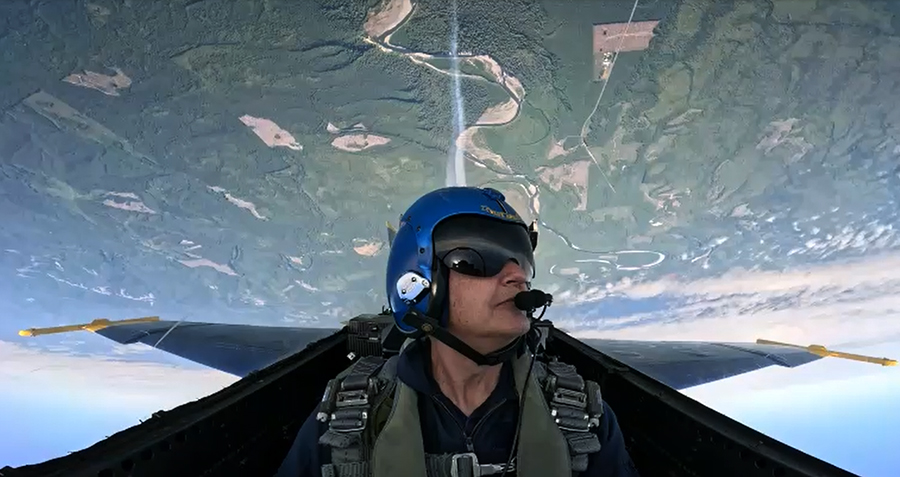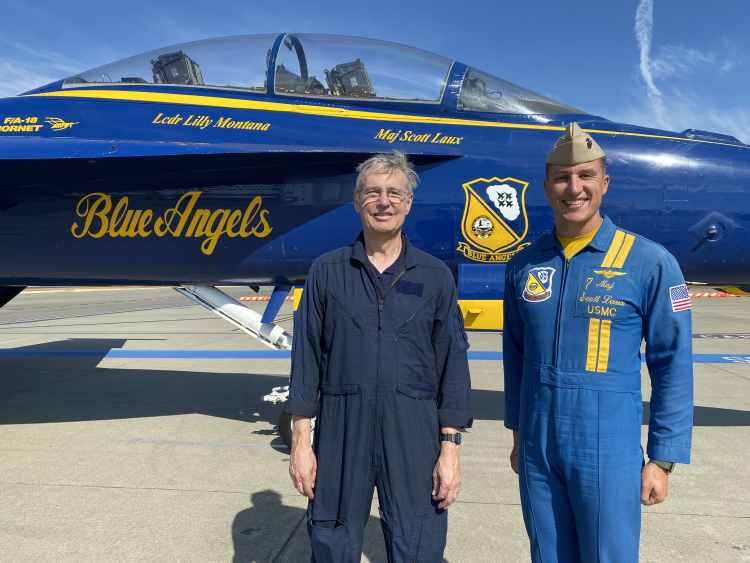Amy Sprague
August 28, 2025

Professor Hermanson flying inverted in the Blue Angels’ F/A-18 Super Hornet.
In the buildup to Seattle's Seafair 2025, Professor Jim Hermanson got the chance to experience what thousands of spectators witness from the ground - but from the back seat of a Blue Angels F/A-18 Super Hornet. The rare flight opportunity gave him a firsthand look at the precision flying and cutting-edge technology that make the Navy's premier flight demonstration squadron a Seattle summer tradition.
For Hermanson, who has spent more than a decade connecting UW students with Navy career opportunities, the flight represented both a personal milestone and a powerful teaching tool. Professor Hermanson shared more of his amazing experience.
What was it like flying with the Blue Angels?
As the canopy came down on that F/A-18, I had one of those "am I really doing this?" moments. But what followed was absolutely phenomenal. Major Scott Laux, my pilot, kept us in constant communication throughout the flight - warning me before each maneuver, explaining what we were doing. Having an aeronautical engineer as a passenger who understood the physics of aviation seemed to energize him too. We pulled everything from gentle 2-g turns to an almost-vertical afterburner takeoff to a crushing 7.5-g turn that had me pressed hard into my seat. In addition to the afterburner takeoff, we performed a full loop — looking "up" at the ground was an incredible experience.
What surprised you most up there?
Professor Hermanson and Major Scott Laux before takeoff.
Flying inverted was surreal - reaching for something in the cockpit became completely disorienting when you're looking "up" at the ground below. And I learned to appreciate the importance of proper muscle tensing for high-g maneuvers. We did turns with increasing g-levels of 2, 4, 6 and 7.5 g’s. During a 4-g turn, I did not properly tense up and started to "grey out" as my vision faded. Major Laux explained that it’s at 4 g’s that most people start to experience that effect. Lesson learned! Happily, with suitably tensed muscles, all of the higher-g maneuvers (up to 7.5 g's) went fine, though the sudden loading at 6+ g’s was intense!
How did this rare opportunity come about?
This was years in the making. I've been supporting Navy outreach at the UW for over a decade, and I'd always ask about the possibility of flying with the Blues. It finally came together this year with help from Admiral Ian Johnson and Commander Anna Padleckas, whose visit to our campus last April I hosted. These opportunities are incredibly limited - essentially once-in-a-lifetime.
This isn't your first Navy experience though, is it?
Not at all - this experience caps off more than 15 years of extraordinary Navy experiences. It began in earnest when I was department chair in 2010 with a submarine embark on the USS San Francisco out of San Diego. We dove, cruised underwater, resurfaced, and I got to tour all of the compartments forward of the reactor and propulsion spaces. Then in 2019, I flew out to the USS Theodore Roosevelt aircraft carrier - that included an arrested landing, a full day observing shipboard operations, and a catapult launch takeoff. Each experience has given me incredible stories to share with our students during numerous Navy recruitment briefings.
What prompted your interest in working with the Navy?
When I graduated from high school, I was torn between two strong career aspirations. One was to join the Navy and drive submarines; the other, to explore outer space. I chose the latter and have focused my academic and industry career on working in aerospace. At the same time, I have always pondered that "path not taken" — the Navy career — and have been delighted to experience many aspects of it first-hand.
What consistently impresses you across all these experiences?
Three things always stand out: the cutting-edge technology, the seamless teamwork and dedication of all involved, and the critical importance to national security. Whether it's a submarine, aircraft carrier, or the Blue Angels, I see engineering at its most advanced and people working together flawlessly in high-stakes environments. I tell students that military careers offer the chance to work with "the real stuff" - hands-on with technology that pushes boundaries while serving something essential to our country's defense.
How does this connect to your work at the UW?
This experience gave me direct, hands-on experience with aerospace technology at its most extreme. I teach propulsion courses, and now I can share real-world examples of these principles in action with our students. There's nothing quite like experiencing 7.5 g's or flying on afterburners to understand the engineering challenges involved.
In the end, I'd like to impart two considerations to our students. The first is to be flexible and open to different career choices and experiences, and work to develop your own path — and it will be a good one! The second is to identify what you really want to do, and do what it takes to get you there — you'll always be glad you did!
